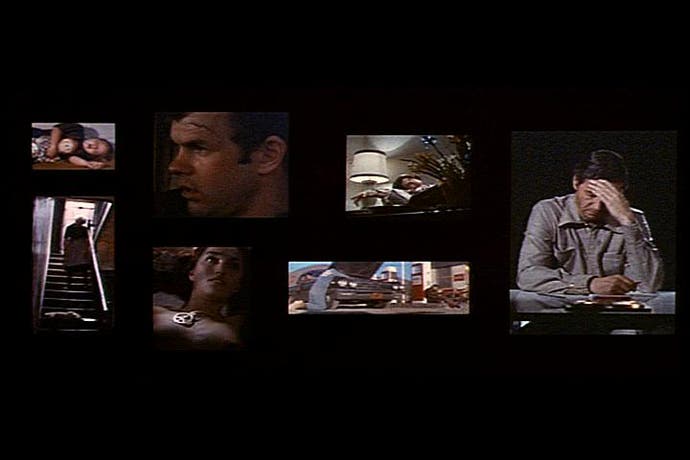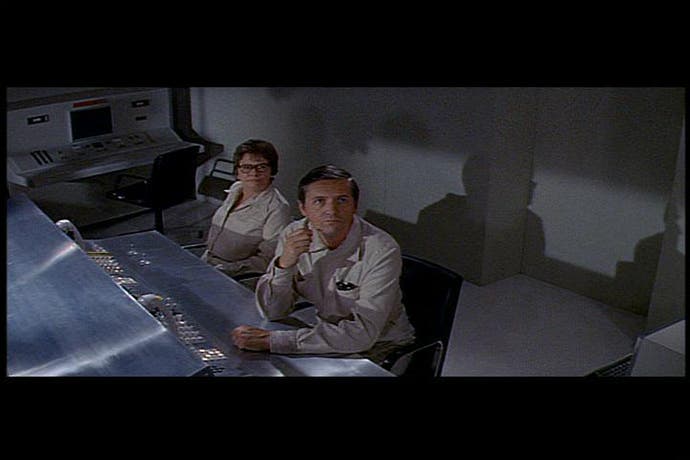The Andromeda Strain
Review - we take a look at the classic scientific thriller which began Michael Crichton's rise to the top of the movie industry back in 1971
- Robert Wise Screenplay - Nelson Gidding / Michael Crichton Starring - Arthur Hill David Wayne James Olson Kate Reid Rating - 12 Filmed - USA, 1971 DVD by - Universal

Wildfire
The first of Michael Crichton's many novels to be transformed into a movie, "The Andromeda Strain" is a tense scientific thriller based, like so many of Crichton's works, around the idea of scientists playing god and unleashing powers that they can't control. As one of the movie's characters comments, "we've had experiences with scientists before".
In "Jurassic Park" it was cloned dinosaurs, in "Westworld" it was robots, and in The Andromeda Strain it is .. alien microbes. While it might not sound like the most exciting of topics, the combination of Crichton's original novel as its basis and terse but effective direction from industry veteran Robert Wise ("The Day The Earth Stood Still") proved to be a winner.
The village of Piedmont, New Mexico had a population of just 68, until a military satellite code-named Project Scoop landed nearby after straying off-course during re-entry on February 5th 1971. Scientists arrive to recover the satellite, only to find the village littered with corpses. "We see bodies, lots of them", the recovery team reports over the radio as the supervisors at Vandenburg Air Force base listen in shock. "They're all over the place, there must be dozens of them".
A "wildfire alert" is called, and a team of four top scientists from around the country is hurriedly assembled at a secret bio-hazard lab in the deserts of Nevada. Their mission is to isolate and identify the alien virus which was brought back by Scoop, and to discover a way of neutralising it before it can spread any further. Their only clue is the two survivors of the disaster - an old man and a baby. "I'll have the answer when I know why a 69 year old sterno drinker with an ulcer is like a normal six month old baby", team doctor Mark Hall declares.

Decontamination
The whole film is shot in a semi-documentary style, right down to voice-overs from a supposed Senate committee hearing into the crisis a couple of months later, and this only helps add to the mounting tension. It's chilling stuff, and despite the almost total lack of action and a rather lengthy two and a quarter hour running time, it manages to keep your attention throughout.
Scientific accuracy, or at least believability, is usually a key element of Crichton's work, and The Andromeda Strain is no exception - as Dr Hall says, "I never went in much for science fiction". The laboratory and its draconian sixteen hour decontamination procedure are all recreated with stark and painstaking detail, and Andromeda itself is brought to life thanks to some trippy computer generated effects.
Laboratory equipment ranging from glove boxes and robotic "waldo" arms to electron microscopes are all present and correct, and there's plenty of scientific jargon and experimental procedures for geeks to get stuck into, although some of it is a little dated by today's standards, particularly the primitive computer systems. The sight of the scientists exposing lab rats and monkeys to the virus to determine its effects and lifespan is rather shocking as well, the animals panting and convulsing as the virus spreads through their blood system, killing them in a matter of seconds...

Clinical
The whole thing is filmed in a subdued and almost clinical manner, as sterile as the clean rooms on Level 5 of the secret wildfire facility. In ways it's reminiscent of "2001 : A Space Oddysey", which was released just a few years earlier, and it's a highly effective approach for the rather abstract subject matter and scientific detachment of the main characters as they investigate the alien life form. Director Robert Wise went on to use the same cold style again several years later in "Star Trek : The Motion Picture", much to the consternation of Trekkies everywhere...
Dialog in the Andromeda Strain is terse and highly technical a lot of the time, and the acting is mostly very restrained, although the cast deserve a commendation for making lines like "I didn't think the total volume of blood could solidify that fast" sound suitably menacing. In a way the scientists are more caricatures than characters, from calculating team leader Dr Stone ("stick to established procedure") to sarcastic biologist Dr Ruth Leavitt. This just makes it more shocking when they lose their cool detached outlook though, leading to a genuinely exciting climax.
There are occasional lapses into borderline psychedelia thanks to some rather trippy special effects, as well as a little experimental split-screen camera work of the kind which was popular for a few years in the late 60's and early 70's, where different scenes are combined into a single frame. It's used sparingly and works surprisingly well though, especially as the scientists explore the village of Piedmont, the footage of them walking from door to door interspersed with photographs of victims of the microbe.

The Disc
The Region 1 DVD came as something of a disappointment, totally lacking in any kind of extra features, unless you count the illustrated scene access menu, which is useful but hardly exciting. There are no trailers, no commentary tracks, no cast and crew biographies, no stills galleries, nothing.
The movie is presented at the original aspect ratio of around 2.35 : 1, but that's about as far as the good news goes. Sadly it has not aged well in the last thirty years, and the print it is taken from is dark and grainy at the best of times, with unremarkable (and rather quiet) mono sound. The problems don't end there either - the transfer has brief but noticeable compression and aliasing artefacts in a few places, although luckily it's not too serious.
Overall it's a decent effort for a movie which is well past its prime, but if you already own it on video there's no good reason to buy the DVD as well, as the picture quality isn't any better than a good video copy, and there are no extra features to speak of. If you don't already have a copy on video it's well worth a look though, as the film itself is excellent, the DVD is cheap, and sadly this is the best version we are likely to see, unless somebody digs up a better print or takes the time and effort to digitally remaster it after all these years. Film - 8/10 Disc - 4/10 Availability -
Amazon - $12.74 + P&P
Express.com - $12.74 + P&P
DVD Empire - $11.95 + P&P
Note - All information is correct at time of writing, but prices and availability may change. If you find any broken links or other problems, please let us know.

